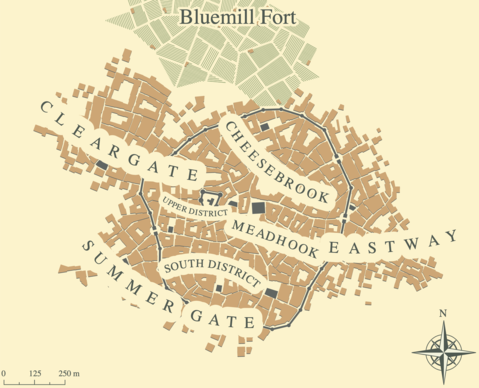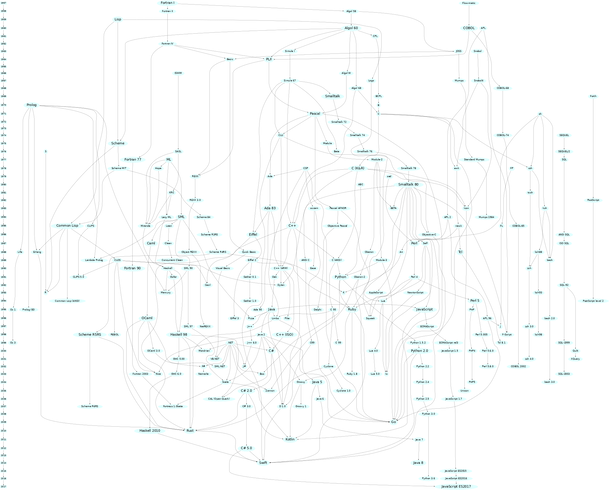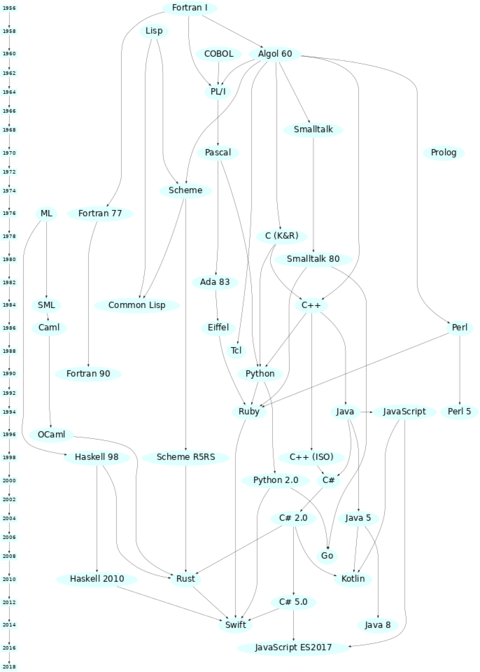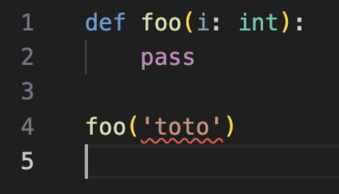Intermediate Python – Part 1#
Thierry Géraud 2024

print("Hello world!")
Test: write a Python program that input a number of lines and stores the strings in an appropriate structure
such as:
*
***
or:
*
***
*****
email me your solution at thierry.geraud@epita.fr with the tag [INTPY] in the subject

Let’s start with a few questions…#
What language(s) do you know?
your answers : C/C++, ruby, javascript, HTML, brainfuck, ... but not "english, or french..."
What is Python?
How do you use it?
What for?
Describe Python…
answers...
We will come back to this in a few minutes…
$e^{i\pi} = 1$ gives: $e^{i\pi} = 1$
What have we here?
answer: a description language (LaTeX)... not a programming language
% for i in ls -d *; echo $i
What is it? Is it programming?
answers:
- a loop in shell (zsh); that is an instruction; we are scripting
- we do not have a program at the end, so no
What is a programming language?
answer:
read https://en.wikipedia.org/wiki/Programming_language
Courses / lectures + sessions of practical work
Your 1st project: display a map described by a file

Characterization of Python#
Python is:
free and open-source software
portable
a programming language which is
high-level
general-purpose
multi-paradigm
easy to learn, easy to code, easy to read → accessible
equipped with a large standard library, plus a vast range of libraries.

history of programming languages → http://tinyurl.com/IntPyLanguages
 Fetch “
Fetch “
High-level language#
compare with some assembler code:
Fib PROC
mov eax, 1
xor ebx, ebx
xor edx, edx
L1:
add eax, ebx ; eax += ebx
mov ebx, edx
mov edx, eax
loop L1
ret
Fib ENDP
General-purpose language#
broadly applicable across application domains
e.g., bank, medicine, science
lacking specialized features for a particular domain
a counterexample: solve some constraint-based problems (use Prolog instead)
note that libraries (except the standard one(s)) are not part of the language
a related key idea: a language now comes with an environment, and a community
A multi-paradigm language#
Python is:
imperative
procedural
structured
object-oriented
somehow a bit
functional
generic
Imperative#
a = 0
a += 1
a series of instructions that change the state of the running program
Procedural#
def fact(n):
return 1 if (n == 0 or n == 1) else n * fact(n - 1)
# an example of "literate programming" here
a procedure is great to factor code, to be called many times
Structured#
with control structures (e.g., for, if)
with blocks – thanks to indentation
for i in range(len(lst)):
if i % 2 == 0:
print(lst[i], end = '\n')
i = i - 1
elif i == 7:
break
subroutines
print(lst) # this is a procedure call
subroutines are procedures (functions) and methods
compare with basic code:
05 HOME : TEXT : REM Fibonacci numbers
10 LET MAX = 5000
20 LET X = 1 : LET Y = 1
30 IF (X > MAX) GOTO 100
40 PRINT X
50 X = X + Y
60 IF (Y > MAX) GOTO 100
70 PRINT Y
80 Y = X + Y
90 GOTO 30
100 END
and
GOSUB
for subroutines
Object-oriented#
class Door:
def __init__(self, number, status='closed'):
self.__number = number
self.status = status
def open(self): # this is a method
self.status = 'opened'
# cut
d = Door(42)
d.open() # this is a method call
print(d.status)
in this code snippet, ‘d’ is a Door
A bit functional#
l = list(range(0, 4))
l2 = list(filter(lambda x: x > 2, l))
we have the function: x $\mapsto$ x > 2 (this is not a procedure)
A bit generic#
T = TypeVar('T')
def first(seq: Sequence[T]) -> T:
return seq[0]
returns the first element
About types / typing#
Object = instance of a type / result of the instanciation of a type
Type = description of all the objects with this type
d0 = Door(0)
dd = [Door(i) for i in range(10)]
here d0 and dd[i] are doors / are of type Door
they are independant, yet they behave the same way
A simple test than you shall pass#
run
print(type(d))
print(first(d))
on
d = (0, 1, 2)
d = [0, 1, 2]
d = {0, 1, 2}
d = {'pi': 3.14, 'e': 2.72}
what are the output? why?
Python has some built-in types:
Numeric data types: int, float, complex
String data types: str
Sequence types: list, tuple, range
Binary types: bytes, bytearray, memoryview
Mapping data type: dict
Boolean type: bool
Set data types: set, frozenset
multiple-item data types are called collections or containers
Comment the difference(s):
T = TypeVar('T')
def first(seq: Sequence[T]) -> T:
return seq[0]
# versus
def first(seq):
return seq[0]
def sqr(x: int) -> int:
return x * x
#versus
def sqr(x):
return x * x
b: int = 2
#versus
b = 2
b: str = 2
print(type(b))
def doit(i: int):
print('int', i)
def doit(s: str):
print(type(s), s)
doit(0)
doit("0")
What happens? Why?
use a linter!

and a type checker:
Mypy (by Dropbox), Pytype (by Google), Pyright (by Microsoft)
Pyre/Pysa (at Facebook and Instagram)

Variables, values, and types#
py:
a = 1 # implicit type for 'a' -- typed by the compiler
b: int = 2 # explicit type for 'b'
b = "a string" # do compile; 'b' is now a string
Pascal:
var b : integer = 2; // types have to be explicit
modern C++:
auto a = 1; // implicit type
int b = 2; // explicit type
auto b = "a string"; // do not compile: 'b' is already defined!
py:
a = 1
ida = id(a)
a = 2
print(id(a) == ida) # gives: False
we cannot change the value of the integer whose identity is ‘ida’
$\leadsto~$ integers are immutable in Python
py:
a = 1
ida = id(a)
b = a # 'b' is actually a reference to 'a'; we can say that 'b' is 'a'
print(id(b) == ida) # gives: True
b = 2 # now 'b' designates a new integer
print(id(b) == ida) # gives: False
print(a) # gives 1
single-item data types (integers, floats, complex numbers, Booleans) are immutable
strings and tuples are immutable
whereas
lists, sets, and dictionaries are mutable
Exercice#
def foo(b):
print(id(b), b)
def bar(c):
print(id(c), c)
c = 2
print(id(c), c)
a = 0
print(id(a), a)
foo(a)
bar(a)
print(id(a), a)
What is printed? Explain. What the rationale behind it?
py:
l = [1, 'a string']
idl = id(l)
l.append(Door(0))
print(id(l) == idl) # gives: True, lists are mutable
print(l) # gives: [1, 'a string', <__main__.Door object at 0x7f568add0790>]
for e in l:
print(e) # gives: ???
Explain:
why the behavior hopefully differs from the previous example
the output of print(l)
the output of the for loop, and how we can make it possible?
class Door:
def set_number(self, number):
self.__number = number
# cut
py:
# cont'd
print(id(l), id(l[2]), l[2])
for e in l:
if isinstance(e, Door): # same as: if type(e) == Door:
e.set_number(2)
print(id(l), id(l[2]), l[2])
what is the output? what have we done here?
Structured programming and blocks#
Python:
def doit(lst):
for i in range(len(lst)):
if i % 2 == 0:
print(lst[i], end = '\n')
i = i - 1
elif i == 7:
break
blocks start with ‘:’ and rely on indentation
Equivalent code in C++:
void doit(std::list<int>& lst)
{
for (int i = 0; i < lst.size(); ++i)
if (i % 2 == 0) {
std::cout << lst[i] << '\n'; // do not compile! Why?
i = i - 1;
}
else if (i == 7) {
break; } // the two braces are useless here
}
blocks are delimited by ‘{’ and ‘}’, and indentation does not matter
an instruction (not a block of instructions) ends with ‘;’
in Python indentation matters
i = 1
i = 0 # gives: IndentationError: unexpected indent
and it is the key to see blocks
i = 0
while i < 5:
print(i)
i += 1
vs
i = 0
while i < 5:
print(i)
i += 1
compare with COBOL (1959):

column 7 is for an indicator:
‘*’ means that it is a comment
‘-’ means that it is the continuation of the previous line
‘/’ means that, when printing your code listing, it would page break
‘D’ means that the line would only compile when in debugging mode
compare with FORTRAN 66:
program circle
real r, area
c This program reads a real number r and prints
c the area of a circle with radius r.
write (*,*) 'Give radius r:'
read (*,*) r
area = 3.14159*r*r
write (*,*) 'Area = ', area
stop
end
Memory#
a = 1 # new object => memory allocation
b = a # no new object
b = 2 # b is a new object => memory allocation
# no need for explicit memory deallocation
py:
d = Door(1) # new object
print(d.status)
d.open() # method call
# no need for memory deallocation
Python relies on a garbage collector to free memory
Read about
heap and stack
reference counting
the mark and sweep algorithm https://en.wikipedia.org/wiki/Memory_management https://en.wikipedia.org/wiki/Tracing_garbage_collection
The programmer can not care about memory; yet he/she shall know:
del my_large_container
gc.collect()
Python as an object-oriented language#
A particular way of thinking:
a program = data types and algorithms (functions)
example in C:
struct rectangle { // a data type
float width, height;
};
void scale(rectangle* r, float s) { // an algorithm
assert(r != NULL and s > 0);
r->width *= s;
r->height *= s;
}
Compare:
dta = [("EPITA", "Kremlin-Bicetre"), ("Sorbonne University", "Paris 5")]
print("name=", dta[0][0], "where=", dta[0][1])
with:
@dataclass
class University: # what have we here?
name: str = None
location: str = None
dta = [University("EPITA", "Kremlin-Bicetre"),
University("Sorbonne University", "Paris 5")]
print(f"name = {dta[0].name} where = {dta[0].location}")
print(dta[0]) # works directly!
from dataclasses import dataclass
@dataclass
class University: # a data type
name: str = None # grouping two strings
location: str = None
meaning that a university is composed of two data: name and location, both being strings
u1 = University("EPITA", "Kremlin-Bicetre") # a particular university, u1
print(u1.name) # gives: EPITA -> so *explicitly* print its name
print("Paris" in u1.location) # more readable than 'u1[1]'
we have defined a type:
to be able to have objects with that particular type
a “University” is far more precise than “just two strings”
to store data and explictly access to one piece of data
“.location” is way more explicit than “[1]”
that is what you have in all python libraries: types
they are the keystones of these libraries
the librairies also provide algorithms
doing stuff / transforming data is the key features of these libraries
# a data type
@dataclass
class University:
name: str = None
location: str = None
# an algorithm, dedicated on objects being a University
def relocalize(u: University):
if u.location == "Kremlin-Bicetre":
u.location = "Grand Paris"
sample use:
dta = [University("EPITA", "Kremlin-Bicetre"),
University("Sorbonne University", "Paris 5")]
# 'dta' is a list of two universities
for u in dta:
relocalize(u)
# we have relocalized all universities in 'dta'
in:
# a data type
@dataclass
class University:
name: str = None
location: str = None
we say that: we have define a class (a type) with two attributes (named ‘name’ and ‘location’)
in this example, its is a particular class that has only data; it is “just a data type”
in this example, algorithms are defined on the side (usually nearby)
this is the case of ‘relocalize’
algorithms are not within the type
this example corresponds to:
a program = data types and algorithms (functions)
Another way to describe programs:
a program = a set of types and their relationships
so having a a type is having both data and algorithms
and the next level will be to think about their relationships…
this is the object-oriented way, and Python is an OO language
we are moving from scripting (toy use of Python) to programming (industrial use of Python)…
now:
a type = data + algorithms on these data
in object-orientation, a class has attributes and methods:
description-level |
instance-level |
meaning |
|---|---|---|
class |
object |
an entity (*) |
attributes |
data |
its state |
methods (properties) |
(sub)routines |
its behavior |
(*) a thing that has its own identity and whose identity conforms to what it is / to its type
end of course #1
